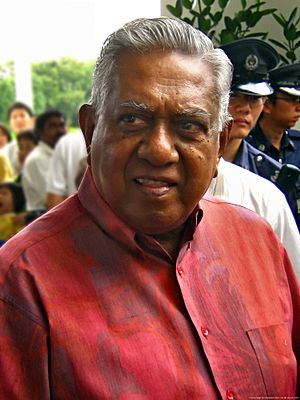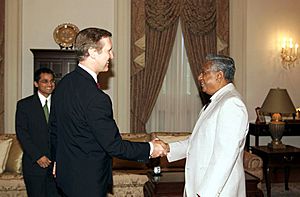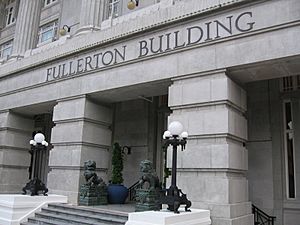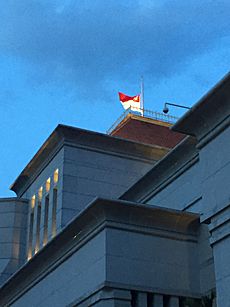S. R. Nathan facts for kids
Quick facts for kids
S. R. Nathan
DUT PJG
|
|
|---|---|
| செல்லப்பன் ராமநாதன் | |

Ramanathan in 2006
|
|
| 6th President of Singapore | |
| In office 1 September 1999 – 31 August 2011 |
|
| Prime Minister | Goh Chok Tong Lee Hsien Loong |
| Preceded by | Ong Teng Cheong |
| Succeeded by | Tony Tan |
| Singapore Ambassador to the United States | |
| In office 20 September 1990 – June 1996 |
|
| President | Wee Kim Wee Ong Teng Cheong |
| Preceded by | Tommy Koh |
| Succeeded by | Chan Heng Chee |
| Singapore High Commissioner to Malaysia | |
| In office April 1988 – July 1990 |
|
| President | Wee Kim Wee |
| Director of the Security and Intelligence Division | |
| In office August 1971 – February 1979 |
|
| Prime Minister | Lee Kuan Yew |
| Preceded by | Tan Boon Seng |
| Succeeded by | Eddie Teo |
| Personal details | |
| Born |
Sellapan Ramanathan
3 July 1924 Singapore, Straits Settlements, British Malaya |
| Died | 22 August 2016 (aged 92) Singapore |
| Cause of death | Stroke |
| Resting place | Mandai Crematorium |
| Political party | Independent (1999–2011) |
| Other political affiliations |
People's Action Party (1966–1988) |
| Spouse | Urmila Nandey |
| Children | 2 |
| Alma mater | University of Malaya |
| Occupation |
|
Sellapan Ramanathan, known as S. R. Nathan, was a very important person in Singapore. He served as the sixth President of Singapore from 1999 to 2011. He was the longest-serving president in Singapore's history.
Nathan became president without anyone running against him in the 1999 election. He was re-elected in the 2005 election in the same way. In 2009, he became Singapore's longest-serving president. He decided not to run for a third term.
S. R. Nathan passed away on 22 August 2016, at the age of 92, after having a stroke.
Contents
Early Life and Education
Nathan was born in Singapore on 3 July 1924. His family was of Indian descent. He spent his early years in Muar, Johor, which is in Malaysia. His father worked as a lawyer's clerk. However, the Great Depression in the 1930s caused his family to lose their money. Nathan's father died when Nathan was only eight years old.
After returning to Singapore, Nathan went to Anglo-Chinese Primary School and Victoria School. He was expelled from school twice. At 16, he left home after an argument with his mother. During the Japanese occupation of Singapore, he learned Japanese and worked as a translator for the Japanese police.
After the war, he finished his secondary education through a home study course. He then went to the University of Malaya in Singapore. He graduated in 1954 with a special diploma in Social Studies.
Career in Public Service
Nathan began his long career in the Singapore Civil Service in 1955. This meant he worked for the government. He first worked as a social worker helping people.
From 1962 to 1966, he worked with the National Trades Union Congress (NTUC). This organization helps workers. He then moved to the Ministry of Foreign Affairs and the Ministry of Home Affairs.
In 1971, he became the Director of the Security and Intelligence Division (SID) in the Defence Ministry. In 1974, there was a serious event called the Laju incident. Terrorists bombed oil tanks. Nathan was one of the government officers who bravely volunteered to go with the terrorists to Kuwait. This helped to free people who were held hostage. For his courage, he received the Pingat Jasa Gemilang (Meritorious Service Medal).
Nathan later became the First Permanent Secretary of the Foreign Ministry from 1979 to 1982. After that, he left the Civil Service to lead a newspaper company, the Straits Times Press.
From 1988 to 1996, he served as Singapore's High Commissioner to Malaysia. He was also the Ambassador to the United States. An ambassador represents their country in another country.
After his time as ambassador, Nathan became a special ambassador and director of a research institute. He left these roles in 1999 to run for president.
Presidency (1999–2011)
Nathan was elected as Singapore's sixth president on 18 August 1999. He was the only candidate, so he won without a contest. He officially became president on 1 September 1999.

As president, Nathan started the annual President's Challenge in 2000. This is a charity event that raises money for good causes. By 2016, this initiative had raised about S$160 million.
In the 2005 election, Nathan was again the only eligible candidate. He was re-elected for a second term on 17 August 2005. He is the only person to have served two terms as president.
In 2009, Nathan approved the government's request to use $4.9 billion from Singapore's past savings. This money was used to help businesses and save jobs during a difficult economic time. This was the first time a president used these special powers.
Retirement
On 1 July 2011, Nathan announced that he would not seek a third term as president. He said his age was a reason, as he was 87 and felt the job was very demanding. He left office on 1 September 2011. Tony Tan became the next president.
After retiring, Nathan wrote books. He also became a special senior fellow at the Singapore Management University (SMU) and the Institute of Southeast Asian Studies. He continued to support various organizations.
Personal Life
S. R. Nathan married Urmila Nandey in 1958. They had one son and one daughter.
Death and State Funeral
Nathan had a stroke on 31 July 2016 and was taken to the hospital. He passed away on 22 August 2016, at the age of 92. He was survived by his wife, two children, and three grandchildren.
To show respect, the National Flag was flown at half-mast on all government buildings for several days. Nathan's body was placed at Parliament House on 25 August. This allowed members of the public to pay their last respects.
On 26 August, a state funeral was held for Nathan. His body was carried on a special gun carriage from Parliament House to the University Cultural Centre at the National University of Singapore (NUS). The funeral procession passed by places important to his life. These included City Hall, where he attended National Day Parades, and The Fullerton Hotel Singapore, where he once worked.
Leaders and ambassadors gave speeches at the funeral. A special Tamil song, "Thanjavooru Mannu Eduthu," was played. It was Nathan's favorite song because he felt it represented Singapore's many different cultures. After the funeral, a private cremation took place.
Legacy and Honours
In 2018, the School of Human Development and Social Services at the Singapore University of Social Sciences (SUSS) was renamed the S R Nathan School of Human Development (NSHD). This was done to honor Nathan's work in supporting social and community causes.
Nathan received many awards for his service. These include the Bintang Bakti Masyarakat (Public Service Star) in 1964 and the Pingat Pentadbiran Awam (Public Administration Medal, Silver) in 1967. In 2013, he received the Darjah Utama Temasek (Order of Temasek), which is a very high honor.
He also received honorary degrees from the National University of Singapore and Singapore Management University. These degrees recognized his contributions to education.
Nathan was the Chief Scout for the Singapore Scout Association when he was president. He received special awards from the Scout Association for his leadership.
His achievements were also recognized by other countries. He received awards from Bahrain, Mauritius, and India. The Indian government gave him the Pravasi Bharatiya Samman award for helping to build stronger ties between Singapore and India.
Images for kids
See also
 In Spanish: Sellapan Ramanathan para niños
In Spanish: Sellapan Ramanathan para niños




